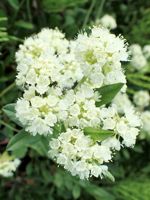Mon-Fri 9am - 5pm Mountain time
White Meadowsweet vs Sulphur-Flower Buckwheat
Spiraea alba
Eriogonum umbellatum
NOT AVAILABLE THIS SEASON - MIGHT RETURN
CUSTOM GROW
White Meadowsweet is a woody, deciduous shrub that begins to bloom in early summer with small white and pink flowers. Its foliage turns from a light green into an attractive golden-yellow later in the fall.
The White Meadowsweet, also known as Mead-Wort or Bride-Wort, is favored by birds and butterflies but is largely ignored by deer. They produce small brown berries in the summer, and while they are technically edible, they are not sweet and are more desired by wildlife.
Sulphur-Flower Buckwheat is a native perennial wildflower known for its dense clusters of cream to yellow flowers. The long-lasting blooms persist from late spring into summer, providing an extended nectar source for a variety of pollinators. The flower buds are often red-tinted before opening. As the blooms age, they shift to orange or red, adding seasonal interest and making them well-suited to dried flower arrangements. Its seeds are also eaten by birds, adding to its ecological value.
Depending on climate and conditions, Sulphur-Flower Buckwheat may be evergreen to semi-evergreen, or its foliage may turn red during fall. Its deep roots and spreading growth stabilize rocky or sandy soils, making it useful for erosion control. Exceptionally hardy once established, it requires little care and thrives in challenging environments, making it an excellent choice for pollinator gardens, naturalization, and ecological restoration projects.

